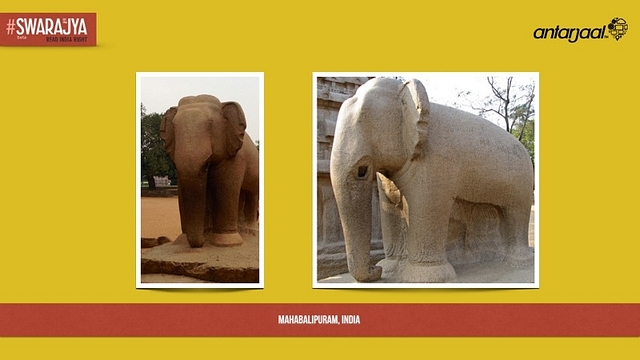
Elephants Come To Life
The elephant has overawed generations of humans since early history. Here, Swarajya presents some of the most unique depictions of the animal in stone reliefs from across the world.
Many cultures admire and associate the elephant with might, wisdom and great memory. Elephants have been revered in religion and respected in military for their might in war. This fascination with the majestic beast in borne out by the various sculptures depicting it across Asia and Europe.
We take a look at two types of sculptures that depict elephants. One type that displays strength and majesty while another narrates a humble vulnerability.
The stoic elephant
An independent monolithic sculpture of an elephant is one of the attractions at the Pancha Ratha complex at Mahabalipuram in Tamil Nadu. Also known as Pandava Ratha this complex is an example of monolithic rock-cut architecture dating from the 7th Century attributed to king Mahendravarrman I and his son Narasimhavarman I.
(Credits: McKay Savage on flickr)
The elephant sculpture is located next to the Nakula Sahadeva Ratha, is simple in design with no decorations and yet is the one that most travellers would want to have their photos taken with. The elephant here is conspicuously missing tusks.
Sculptures similar to the independent elephant at Mahabalipuram can be appreciated at East Mebon in Angkor, Cambodia. The elephants are 2mts in height, decorated with chains and bells and stand independently at corners of the first and second tiers. Unlike the statue at Mahabalipuram, this has the stone material completely sculpted out between the front and rear legs.
In Hindu mythology elephants are mentioned as the majestic “vahanas” (vehicles) of Gods, most prominent of those being Airavata – the white elephant that carries Indra. A depiction of Indra atop the three-headed Airavata can also be found here.
(Credits: Wikipedia)
Far away from the places mentioned above is Denmark in Europe. A popular landmark in Copenhagen, the capital of Denmark, is the Elephant Gate at Carlsberg brewery. The gate has four elephants, each pair standing back-to-back as part of a double gateway.
Sculptor Hans Peder Pedersen-Dan apparently created these based on sketches provided to him by architect Vilhelm Dahlerup. The Indian influence on them is clearly visible, both in features of the elephants, based on the shape and proportion of the ears, and the decoration.
A point to note about the cultural significance of elephants in Denmark is that the Order of the Elephant (Danish: Elefantordenen) is the highest order of Denmark with the Danish monarch as the head of the order. It is said that to commemorate the inauguration of the order, the king had two ornamental elephants installed in the “Vor Freslers Kirke” – the King’s Church (The Church of Our Savior).
The vulnerable elephant
Elephant sculptures at Mahabalipuram, Angkor and Copenhagen create awe with their sheer size and stillness. While those at Kanchipuram, Nagapattinam and Srimushnam mesmerize with their narrative and action.
Each of these locations has a panel with a depiction of an elephant giving birth. The mother elephant is aided by other elephants. The panel below, from Kanchipuram, depicts such a child-birth scene with the calf shown half outside the mother.
(Credits: ‘My Travelogue‘)
The panel at Vaikunta Perumal Temple, Kanchipuram shows only two elephants. The one larger in size, who can be assumed to be a male, is shown supporting the mother between its trunk and legs. The pain of the mother is evident in the posture shown where she is almost in a squat with her mouth gasping open and trunk holding on to a tree to help exert pressure to push the calf out.
At Srimushnam, a town in the Cuddalore district of Tamil Nadu, is a temple where one panel shows four elephants, including the mother. The mother elephant is shown with the trunk up and holding on to something strong that can help her exert pressure while another elephant is holding her between its trunk and legs. The other two seem to be providing support by taking on weight of both.
Nagapattinam too has a panel with four elephants including the mother. Here one elephant is holding the mother between trunk and legs. Another is holding the tail of the mother away in-order to remove any hindrance to the calf coming out. The mother has her trunk up and is taking the support of the third elephant to exert pressure.
A point to note here is that all three elephant birth sculptures are in places where Vishnu is the primary deity of worship.